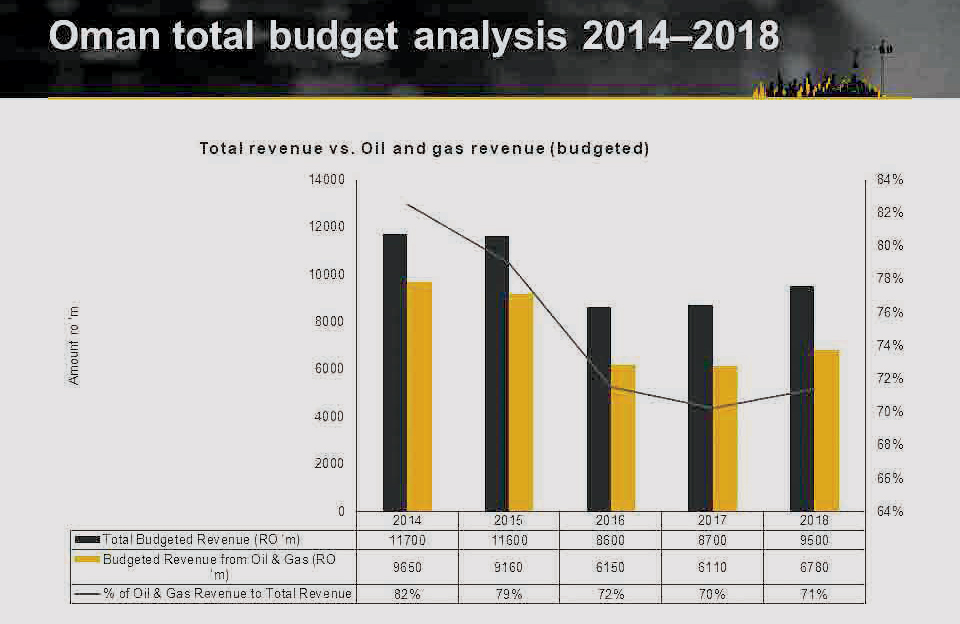

MUSCAT, DEC 29 - Notwithstanding the steep decline in global oil prices over the past month, the price of Omani crude is expected to average out at around $68 per barrel this year — a figure that will have a positive bearing on the choice of a suitable benchmark price on which the 2019 State Budget will be based, according to a Muscat-based analyst.
The Oman Crude Oil Futures Contract slumped to $50.01 per barrel on the Dubai Mercantile Exchange (DME) on Thursday, December 26 — the lowest since this year’s rally in international oil prices which also saw Omani crude soar to a four-year high of $88.96 in September. Global prices have since slid almost 40 per cent with the Oman Crude Futures Contract trading at $53.38 per barrel on Friday, December 28, 2018.
But according to Alkesh Joshi (pictured), Partner — Business Tax Advisory Services at EY Oman, the dramatic drop in oil prices witnessed in recent weeks is unlikely to deter the Omani government from adopting a 2019 State Budget that, while inevitably saddled with a deficit component, will seek to demonstrate continued confidence in the Omani economy.
“My take on the upcoming 2019 State Budget is that the government will continue to invest in the economy,” said Alkesh. “Given its success in raising the finance it needed to bridge funding gaps in previous budgets, the government has since gained a lot of confidence in its ability to secure its funding requirements from international markets. Thus, even if the assumed oil price for the budget is, say $58-60 per barrel, it will still be a deficit budget, which is nevertheless an extremely positive sign that the government still believes in the economy and will continue to spend in order to keep economic activity going.”
Assumed oil price

Boding well for the adoption of a comparatively healthy assumed oil price as the basis for the 2019 budgeting exercise is the average oil price of Omani crude during 2018. Despite the precipitous fall in recent weeks, Omani crude will still average between $68-69 per barrel for the year, according to data compiled by EY Oman.
In the circumstances, an assumed oil price anywhere in the range of $60- 60 per barrel will not be entirely out of place in the drafting of a “manageable” deficit budget, according to Alkesh. “If you go with a $50-60 per barrel price assumption, it will be a good start to put the fiscal numbers together,” he noted.
To help bridge the funding gap, the government has a number of options at hand, according to the EY executive. “Privatisation of state-owned assets will continue in 2019. The government will look to offload some of its controlling stake in some big assets across various sectors with the aim of bringing in foreign participation. Examples are power distribution, power grid management, and so on, assets that can attract foreign investment that will help bridge the deficit.”
Additionally, the Public-Private-Partnership (PPP) framework in the implementation of key infrastructure projects is expected to gain traction going into 2019, said Alkesh. While the government will invest in selective projects, a prominent role for the private sector is anticipated in the development of other projects envisioned across various sectors under the PPP model, he explained.
Bond market

Furthermore, the government will continue to tap overseas financing as much as possible by floating government bonds or Islamic sukuk to help bring in much needed liquidity, Alkesh noted.
Significantly, the recent ratings downgrades announced by a number of international ratings agencies are unlikely to be major hurdle for the government in tapping international markets for its funding needs, says the expert.
“The downgrades have happened to most of the GCC states, and not Oman alone, primarily because the bloc is heavily dependent on the hydrocarbon sector for revenues. The downgrades are linked to the volatility witnessed in oil prices in recent weeks. But despite the downgrades, the GCC economies, including Oman, will be able to tap the international debt market, although they may have go out with a bit of a premium on the coupon. Interest rates will continue to be on the higher side because of the downgrade, but funding will still be made available. After all, any paper that goes from the GCC is still lucrative enough for international investors. The bond market will still be available to the GCC economies and the Oman government as well.”
Non-oil sectors

Alkesh also sees key non-oil economic sectors getting a stronger stimulus for growth in the 2019 Budget. “There is expected to be a greater focus on non-oil sectors, particularly tourism, logistics and free zones. Free zones, in particular, will be positioned as a great investment opportunity for investors from Asia and Far East. The mining sector will gain a lot of importance as well with the government easing the bureaucratic procedures for investment in this industry.”
Value Added Tax (VAT) is also expected to be rolled out in 2019 —its introduction billed as inevitable if oil prices remain low. A draft bill is expected to be progressed through the formal approval process before it is ratified into law.
“VAT will be an economic reality if oil prices don’t rise to, say $58-60 per barrel, on which we expect the 2019 Budget to be based. Rather than have a bigger deficit, the government will have no choice but to diversify the economy more aggressively towards non-oil activities, while taxes will be part of this non-oil revenue space,” he said, adding that excise tax too is also expected to be rolled out in the first or second quarters of 2019.
Oman Observer is now on the WhatsApp channel. Click here



